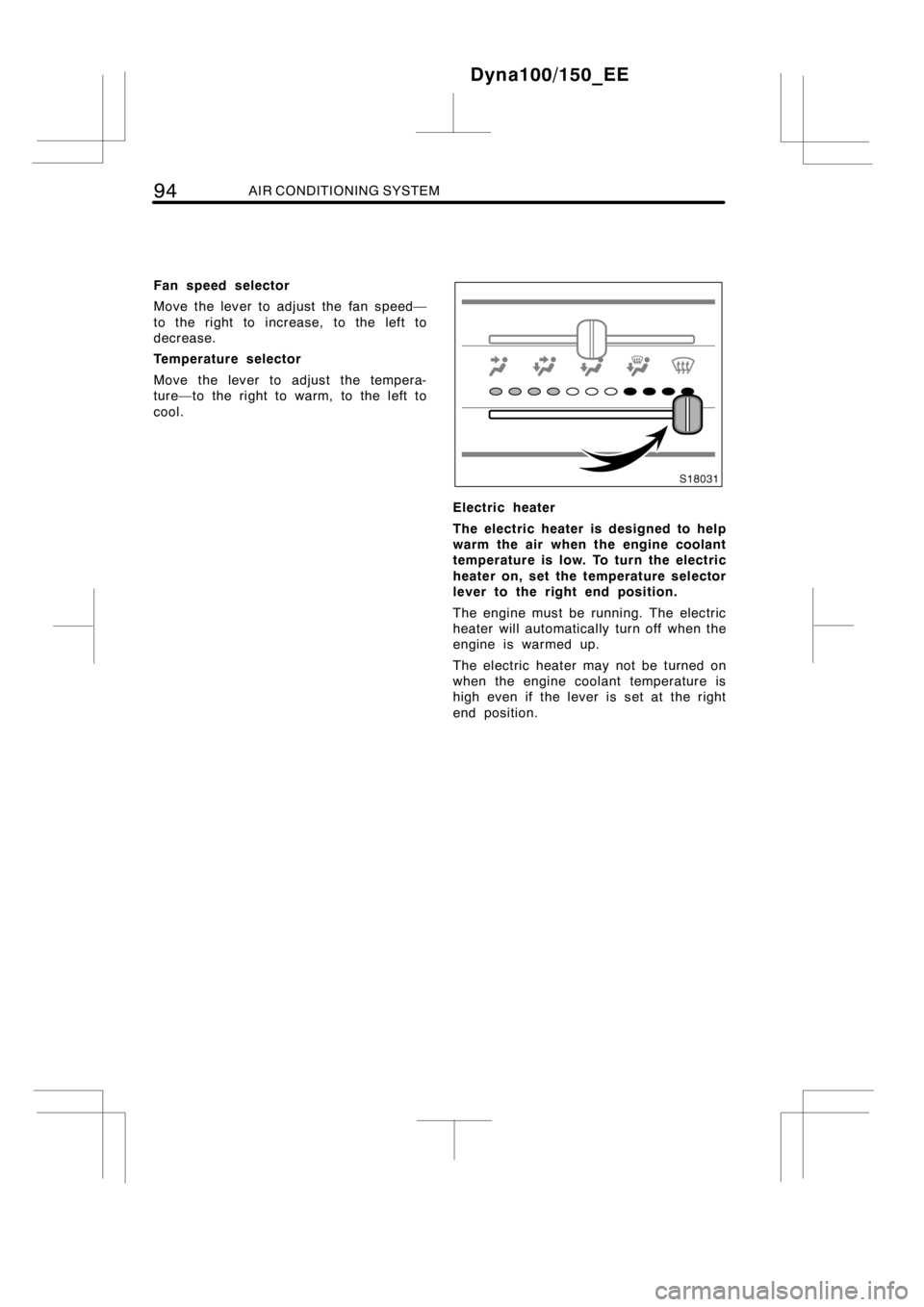2012 TOYOTA DYNA 100/150 Coolant System
[x] Cancel search: Coolant SystemPage 73 of 240

GAUGES, METERS AND SERVICE REMINDER INDICATORS67
Section 1−5
OPERATION OF INSTRUMENTS AND
CONTROLS
Gauges, Meters and Service reminder indicators
DFuel gauge 68.........................................
DEngine coolant temperature gauge 68...................
DTachometer 69........................................
DOdometer and two trip meters 70........................
DOil maintenance managementsystem 70................
DService reminder indicators and warning buzzer 73.......
Dyna100/150_EE
Page 74 of 240

68GAUGES, METERS AND SERVICE REMINDER INDICATORS
The gauge indicates the approximate
quantity of fuel remaining in the tank
when the engine switch is on.
Nearly full—Needle at “F”
Nearly empty—Needle at “E”
It is a good idea to keep the tank over
1/4 full.
The needle moves when braking, acceler-
ating or making turns. This is caused by
the movement of the fuel in the tank.
If the fuel level approaches “E” or the low
fuel level warning light comes on, fill the
fuel tank as soon as possible.
On inclines or curves, due to the move-
ment of fuel in the tank, the fuel gauge
needle may fluctuate or the low fuel level
warning light may come on earlier than
usual.
On some models—
If the fuel tank is completely empty, the
malfunction indicator lamp comes on. Fill
the fuel tank immediately.
The indicator lamp goes off after driving
several times. If the indicator lamp does
not go off, contact any authorized Toyota
dealer or repairer, or another duly quali-
fied and equipped professional, as soon
as possible.The gauge indicates the engine coolant
temperature when the engine switch is
on. The engine operating temperature
will vary with changes in weather and
engine load.
If the needle moves into the red zone,
your engine is too hot. If your vehicle
overheats, stop your vehicle and allow the
engine to cool.
Your vehicle may overheat during severe
operating conditions, such as:
DDriving up a long hill on a hot day.
DReducing speed or stopping after high
speed driving.
DIdling for a long period with the air
conditioning on in stop−and−go traffic.
DTowingatrailer.
NOTICE
zDo not remove the thermostat in
the engine cooling system as this
may cause the engine to overheat.
The thermostat is designed to con-
trol the flow of coolant to keep the
temperature of the engine within
the specified operating range.
zDo not continue driving with an
overheated engine. See “If your ve-
hicle overheats” on page 156 in
Section 4.
Dyna100/150_EE
Fuel gaugeEngine coolant temperature
gauge
Page 100 of 240

94AIR CONDITIONING SYSTEM
Fan speed selector
Move the lever to adjust the fan speed—
to the right to increase, to the left to
decrease.
Temperature selector
Move the lever to adjust the tempera-
ture—to the right to warm, to the left to
cool.
Electric heater
The electric heater is designed to help
warm the air when the engine coolant
temperature is low. To turn the electric
heater on, set the temperature selector
lever to the right end position.
The engine must be running. The electric
heater will automatically turn off when the
engine is warmed up.
The electric heater may not be turned on
when the engine coolant temperature is
high even if the lever is set at the right
end position.
Dyna100/150_EE
Page 107 of 240

AIR CONDITIONING SYSTEM101
Push the switch to increase engine
speed. Push the switch once again to
return the engine to the normal idle
speed.
Use the heater idle up switch to boost the
heating effect in extremely cold conditions
when the vehicle is not moving.
When the engine coolant is hot (normal
operating temperature), thesystem may
not operate.Outside filter
Inside filter
There are both inside and outside air
conditioning filter. The filters are on the
passenger ’s side. Refer to theillustra-
tions above.
The filters may become clogged after
long use. If the operating efficiency of
the heater becomes poor, or if the win-
dows begin to fog up easily, the filters
may need to be cleaned.
Dyna100/150_EE
Heater idle up switch Air conditioning filters—
Page 141 of 240

STARTING AND DRIVING135
Instruments and controls.Especially
make sure the service reminder indicators,
instrument lights, and defroster are work-
ing.
Brakes.Make sure the pedal has enough
clearance.
Spare fuses.Make sure you have spare
fuses. They should cover all the amperage
ratings designated on the fuse box lid.
In the engine compartment
Coolant level.Make sure the coolant lev-
el is correct. (See page 198 in Section
7−2 for instructions.)
Wiring.Look for damaged, loose, or dis-
connected wires.
Fuel lines.Check the lines for leaks or
loose connections.
AFTER STARTING THE ENGINE
Exhaust system.If you notice any
change in the sound of the exhaust or
smell exhaust fumes, have the cause lo-
cated and corrected immediately. (See
“Engine exhaust cautions” on page 122 in
Section 2.)
Engine oil level.Stop the engine and
check the dipstick with the vehicle parked
on a level spot. (See page 196 in Section
7−2 for instructions.)
WHILE DRIVING
Instruments.Make sure the speedometer
and gauges are working.
Brakes.In a safe place, check that the
brakes do not pull to one side when ap-
plied.
Anything unusual?Look for loose parts
and leaks. Listen for abnormal noises.
If everything looks O.K., set your mind at
ease and enjoy your trip!DAlways slow down in gusty crosswinds.
This will allow you much better control.
DDrive slowly onto curbs and, if pos-
sible, at a right angle. Avoid driving
onto high, sharp−edged objects and
other road hazards. Failure to do so
can lead to severe tire damage such
as a tire burst.
Drive slowly when passing over bumps
or travelling on abumpy road. Other-
wise, the impact could cause severe
damage to the tires and/or wheels.
DWhen parking on a hill, turn the front
wheels until they touch the curb so
that the vehicle will not roll. Apply the
parking brake, and place the transmis-
sion in first or reverse. If necessary,
block the wheels.
DWashing your vehicle or driving through
deep water may get the brakes wet. To
see whether they are wet, check that
there is no traffic near you, and then
press the pedal lightly. If you do not
feel a normal braking force, the brakes
are probably wet. To dry them, drive
the vehicle cautiously while lightly
pressing the brake pedal with the park-
ing brake applied. If they still do not
work safely, pull to the side of the road
and call any authorized Toyota dealer
or repairer, or another duly qualified
and equipped professional, for assis-
tance.
CAUTION
DBefore driving off, make sure the
parking brake is fully released and
the parking brake reminder light is
off.
DDo not leave your vehicle unat-
tended while the engine is running.
DDo not rest your foot on the brake
pedal while driving. It can cause
dangerous overheating, needless
wear, and poor fuel economy.
Dyna100/150_EE
Tips for driving in various
conditions
Page 162 of 240

156IN CASE OF AN EMERGENCY
If your engine coolant temperature
gauge indicates overheating, if you ex-
perience a loss of power, or if you hear
a loud knocking or pinging noise, the
engine has probably overheated. You
should follow this procedure...
1. Pull safely off the road, stop the ve-
hicle, and turn on your emergency
flashers. Put the transmission in neu-
tral and apply the parking brake. Turn
off the air conditioning if it is being
used.
2. If coolant or steam is boiling out of the
radiator or reservoir, stop the engine.
Wait until the steam subsides before
opening the engine access hole cover
or tilting the cab. If there is no coolant
or steam boiling over, leave the engine
running and make sure the electric
cooling fan is operating. If it is not,
turn the engine switch off.
CAUTION
To help avoid serious injury, keep the
engine access hole cover closed or
the cab lowered until there is no
steam. Escaping steam or coolant is
a sign of very high pressure.
3. Visually check to see if the engine
drive belt (fan belt) is broken or loose.
Look for obvious coolant leaks from the
radiator, hoses, and under the vehicle.
However, note that water draining from
the air conditioning is normal if it has
been used.
CAUTION
When the engine is running, keep
hands and clothing away from the
moving fan and engine drive belts.
4. If the engine drive belt is broken or the
coolant is leaking, stop the engine im-
mediately. Call any authorized Toyota
dealer or repairer, or another duly qual-
ified and equipped professional, for as-
sistance.
5. If the engine drive belt is O.K. and
there are no obvious leaks, you may
help the engine cool down more quickly
by running it at about 1500 rpm for a
few minutes with the accelerator pedal
lightly depressed.
6. Check the coolant reservoir. If it is dry,
add coolant to the reservoir while the
engine is running. Fill it about half full.
For the coolant type, see “Coolant type
selection” on page 199 in Section 7−2.
CAUTION
Do not attempt to remove the radiator
cap when the engine and radiator are
hot. Serious injury could result from
scalding hot fluid and steam blown
out under pressure.
7. After the engine coolant temperature
has cooled to normal, again check the
coolant level in the reservoir. If neces-
sary, bring it up to half full again.
Serious coolant loss indicates a leak in
the system. You should have it
checked as soon as possible at any
authorized Toyota dealer or repairer, or
another duly qualified and equipped
professional.
Dyna100/150_EE
If your vehicle overheats
Page 191 of 240

MAINTENANCE REQUIREMENTS185
Note, however, that some maintenance
tasks require special tools and skills.
These are best performed by qualified
technicians. Even if you’re an experienced
do−it−yourself mechanic, we recommend
that repairs and maintenance be con-
ducted by an authorized Toyota dealer or
repairer, or another duly qualified and
equipped professional. Any authorized
Toyota dealer or repairer will keep a
record of maintenance, which could be
useful should you ever require Warranty
Service. Should you choose to select a
qualified and equipped professional other
than an authorized Toyota repairer to
service or maintain your vehicle, we
recommend that you request that a record
of maintenance be kept.
The service interval for scheduled main-
tenance is determined by the odometer
reading or time interval, whichever
comes first, shown in the schedule.
Rubber hoses (for cooling and heater
system, brake system and fuel system)
should be inspected by a qualified tech-
nician in accordance with the Toyota
maintenance schedule.
They are particularly important mainte-
nance items. Have any deteriorated or
damaged hoses replaced immediately.
Note that rubber hoses will deteriorate
with age, resulting in swelling, chafing or
cracks.Be on the alert for changes in perfor-
mance, sounds, and visual tip−offs that
indicate service is needed. Some impor-
tant clues are as follows:
DEngine missing, stumbling, or pinging
DAppreciable loss of power
DStrange engine noises
DA leak under the vehicle (However, wa-
ter dripping from the air conditioning
after use is normal.)
DChange in exhaust sound (This may
indicate a dangerous carbon monoxide
leak. Drive with the windows open and
have the exhaustsystem checked im-
mediately.)
DFlat−looking tire; excessive tire squeal
when cornering; uneven tire wear
DVehicle pulls to one side when driving
straight on a level road
DStrange noises related to suspension
movement
DLoss of brake effectiveness; spongy
feeling brake or clutch pedal; pedal al-
most touches floor; vehicle pulls to one
side when braking
DEngine coolant temperature continually
higher than normal
If you notice any of these clues, take your
vehicle to any authorized Toyota dealer or
repairer, or another duly qualified and
equipped professional, as soon as pos-
sible. It probably needs adjustment or re-
pair.
CAUTION
Do not continue driving with the ve-
hicle unchecked. It could result in se-
rious vehicle damage and possibly se-
rious injury.
Dyna100/150_EE
Does your vehicle need
repairing?
Page 204 of 240

198DO−IT−YOURSELF MAINTENANCE: Engine and Chassis
To ensure excellent lubrication perfor-
mance for your engine, Toyota recom-
mends the use of “Toyota Genuine Motor
Oil”, which has been specifically tested
and approved for all Toyota engines.
Please contact any authorized Toyota
dealer or repairer for further details about
“Toyota Genuine Motor Oil”. Other motor
oils of matching quality also be used.Look at the see−through coolant reser-
voir when the engine is cold. The cool-
ant level is satisfactory if it is between
the “FULL” and “LOW” lines on the
reservoir. If the level is low, add the
coolant. (For the coolant type, see
“Coolant type selection” described be-
low.)
The coolant level in the reservoir will vary
with engine temperature. However, if the
level is on or below the “LOW” line, add
coolant. Bring the level up to the “FULL”
line.
If the coolant level drops within a short
time after replenishing, there may be a
leak in the system. Visually check the
radiator, hoses, radiator cap and drain
cock and water pump.
If you can find no leak, have any autho-
rized Toyota dealer or repairer, or another
duly qualified and equipped professional,
test the cap pressure and check for leaks
in the cooling system.
CAUTION
To prevent burning yourself, do not
remove the radiator cap when the en-
gine is hot.
Dyna100/150_EE
Checking the engine coolant
level